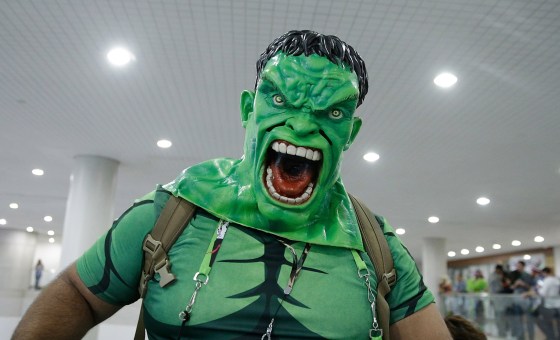Inside of a hot Manhattan club on a Saturday night in October, bartenders pour overpriced drinks to eager patrons as music throbs and large monitors flash image after image.
Then, Deadpool walks by.
Actually, five Deadpools.
No, not the actual Marvel anti-hero comic book character, who will be played by Ryan Reynolds in the highly anticipated film this coming February; instead, it was a row of cosplayers — pop culture and comic book fans who take great pains to dress and sometimes act as their favorite heroes and villains.
Although the club, Slate, typically sees plenty of thigh-high boots and tight shirts, this particular night was different. The tall boots were on some of the women dressed as Japanese anime characters, and the tight shirts were on some of the men dressed as superheroes like Captain America. The party was organized by Jon Haehnle, creative director for Midtown Comics, and his group Sonicboombox, which, among other things, hosts afterparties at New York Comic Con.
"I started doing the events because friends would come into town and they would have nothing to do after the [convention],” Haehnle said.
Haehnle said he has thrown parties from New York to Denver to Hawaii.
"...just to be able to dress up and attend something like this is such a nice change of pace. It adds a big sense of community, too, in seeing all these other people who love all the same things you love."
Cosplay, a combination of the words "costume" and "play," is one of the most recognizable signs of comic and convention culture. It takes a dedicated cosplayer weeks, if not months, to conceive, develop, design, and manufacture a costume.
Most cosplayers are just regular fans with shoestring budgets and homegrown construction skills, but some take cosplaying to the next level.
"When I graduated school, I kind of missed that workaholic feeling and I guess that’s what really happened — I really dove into working all the time, making costumes whenever I’m home,” Stella Chuu, 26, told NBC News on the second day of New York Comic Con earlier this month.
Chuu, who was signing autographs and smiling for cameras at the Sonicboombox booth at Manhattan's Javits Center, was dressed as Sunny Yu, a tough female engineer and warrior from the video game Evolve — complete with a headset, giant faux metal boots, and a power suit.
In her every day world, Chuu works as a digital designer. After the rigors of art school, she found she still had ample creativity leftover from her day job. "That's all I do: I make costumes. It’s my fun time and my work time," she said.
For some participants, cosplaying is more of a calling than a pastime.
“There [are] maybe less than a dozen people in the entire world who actually make cosplay a living," Chuu said. "And the thing is is that it’s not actually cosplay that's their living, it’s everything else it’s doing: promotional modeling, selling products, and such. That’s what gives them income…we’re kind of in a way just freelance models, freelance costumers."
One full-time cosplayer is Yaya Han, who also hosted one of Haehnle's Sonicboombox afterparties in 2013. Han has a business herself with a book, hundreds of thousands of followers on social media, and other deals in the works.
Han began cosplaying in 1999, and would go to small conventions and gatherings. Back then, she said, cosplay was a niche interest in a world that was itself a niche interest.
"Cosplay was almost esoteric,” Han told NBC News.
"That's all I do: I make costumes. It’s my fun time and my work time."
But she found that cosplaying was a novel way to be a fan and, in a way, transform the typical fan paradigm. “Instead of just consuming the source, like watching something or wearing a T-shirt of a character, you’re actually becoming the character,” Han said. "The creative aspect was very fascinating to me from the beginning."
But cosplaying has not come without some concerns. After a cosplayer blogged about being harassed by an all-male television crew at New York Comic Con in 2013, the organizers behind the convention created an anti-harassment policy, which was featured prominently at last year's and this year’s conventions.
Han said fans as a whole are respectful, but that as conventions grow larger, so too must an understanding of boundaries. "I think its all about mutual respect and we just need to educate people more about it,” she said.
On the second day of New York Comic Con, Han was promoting a line of costume patterns in conjunction with McCall, the large sewing pattern company, and also entertaining a long queue of fans.
“I think she just had a really positive attitude towards the cosplay community," longtime fan Claire Huang, 20, told NBC News. "When I was going through my awkward middle school years, I was like, ‘Oh my gosh, she’s really body positive.’"
Huang and her friend William Yu, who were cosplaying themselves as characters from the videogame Steins;Gate, were waiting in line to meet Han.
“We both have to spend a lot of time studying just to get by in school and so just to be able to dress up and attend something like this is such a nice change of pace," Yu told NBC News. "It adds a big sense of community, too, in seeing all these other people who love all the same things you love."
